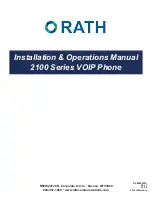
Chapter 4 - Operation
25
cmd:
MYGATE LAW<CR>
When you press the
ENTER
or
RETURN
key, the new identity will be sent and a new
cmd:
prompt returned to your display. You may also
perm
the new gateway identity to avoid the reset
procedure at a future power-up.
Gateway
: Activate the gateway by entering the
Gateway
command and
ON
. Then your station will
automatically digipeat packets received on the VHF port through the HF port and vice-versa. Of
course, packets must contain the Gateway callsign or identifier you have established. Packets pass-
ing via your gateway can be monitored the same as any other packets present on each channel.
While active in the gateway mode, you may also initiate your own Packet conversation on ei-
ther or both HF and VHF. The KAM will also support HF or VHF digipeating while the gateway is
ON.
CW MODE
The primary commands, and their default settings, which affect operation in the CW Mode are:
CWBand
200
CWSpeed
10
CWTone
750
Echo
ON
XMitecho
OFF
You should study these commands, listed in the command section, to determine if you wish to
make any changes prior to entering CW operation. In general, the default settings are the values
most appropriate for use with current transceivers. Your transceiver manual should be consulted to
determine if a CW filter center frequency other than 750 Hertz is used. If non is referenced in your
transceiver manual use the
CWTone
default setting of 750 Hertz.
The CW Mode is entered from the Command Mode by entering the command CW or CW fol-
lowed by a space and 2 digits to establish a specific speed of transmission. If only CW is entered
as the command, the unit will enter CW mode and display its default setting. This is displayed on
the monitor screen as two digits separated by a hyphen. Default setting is 10 wpm. Therefore, the
numbers will display as 10-10. The left number specifies the speed at which you will transmit in
this mode. The right number specifies the receive speed to which the unit is set. Initially this will
always be the same as the transmit speed. When a signal is tuned, the KAM will automatically
search for and synchronize to the signal, up to 99 wpm. The closer you set the initial speed entry
with the CW command, the less time it will take for the unit to track to and synchronize with the
received signal.
In any operating mode other than Packet, you may control the KAM by using the
CTRL-C
com-
mand followed by the appropriate number or letter. Example: when in the CW Mode, to switch
from Receive to Transmit, enter a
CTRL-C
followed by the letter
T
to go into Transmit Mode. To re-
turn to Receive, enter a
CTRL-C
followed by the letter
R
. When making these keyboard entries USE
NO SPACES between the keystrokes.
Now, decide the speed you wish to operate and enter the command. Let's assume you select
15 WPM. Enter the command
CW 15
followed by <
RETURN
>. The leftmost segment of the LED
bargraph will be illuminated. Unless you have designated otherwise, the CW filter center frequency
of 750 Hz is set with a filter bandwidth of 200 Hz.
Tune the receiver until a desired signal is heard. While tuning, observe the LED bargraph and
tune for a full deflection to the right. Receiver tuning will depend on several factors, including
stability of the receiver used, any internal filtering it has, and the setting you have selected for CW
bandwidth set in the KAM. The most common difficulty in learning to tune the KAM for CW signals
is moving the receiver dial too quickly and thus failing to obtain full LED bargraph deflection at the
















































